Balanus glandula Darwin, 1854Common name(s): Acorn barnacle, white buckshot barnacle (when small) |
|
| Synonyms: | 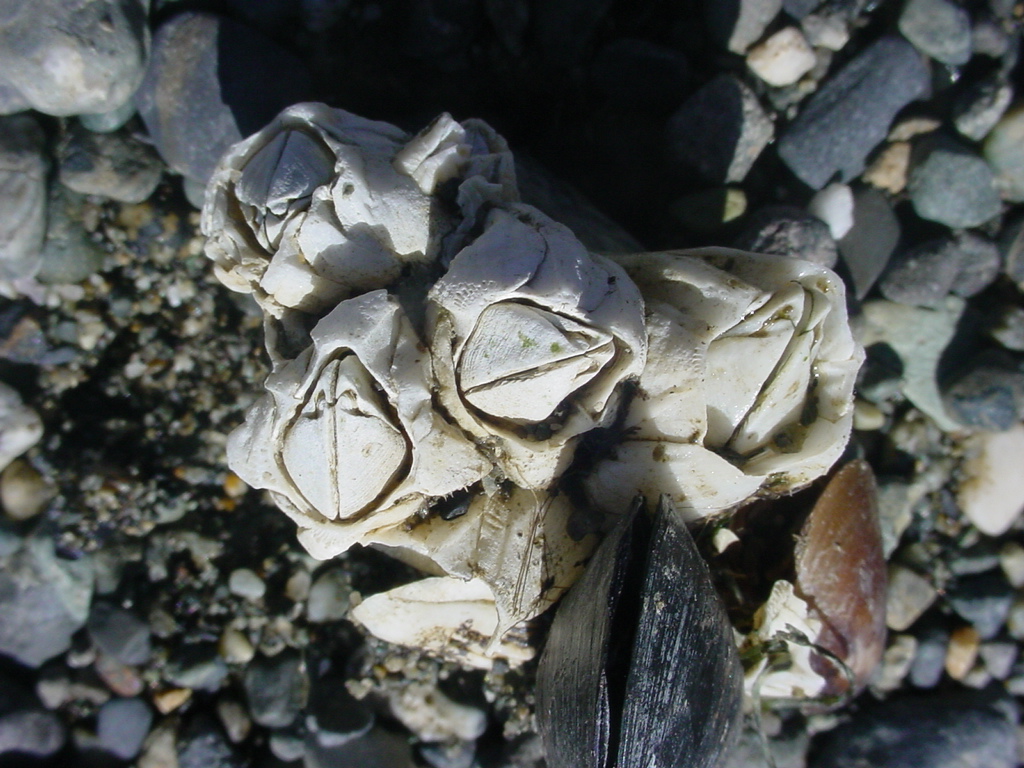 |
| Phylum Arthropoda
Subphylum Crustacea Class Maxillopoda Subclass Thecostraca Infraclass Cirripedia Superorder Thoracica Order Sessilia Suborder Balanomorpha Superfamily Balanoidea Family Balanidae |
|
| Balanus glandula attached to a cobble at Ala Spit, Whidbey Island. Diameter approximately 1.5-2 cm | |
| (Photo by: Dave Cowles, September 2005) | |
How to Distinguish from Similar Species: The sinuous line of contact between the terga and scuta distinguish this species from most other intertidal barnacles. Semibalanus balanoides has a sinuous line of contact but also has no centripetal ridges at the interior base of the shell. The dark patch visible through the scutum is also more prominent in B. glandula. Chthamalus dalli has a straight, crosslike junction between the terga and scuta and the rostrum is overlapped by the adjacent wall plates, which are rostrolaterals.
Geographical Range: Aleutian Islands, Alaska to Bahia de San Quintin, Baja California (most common north of San Francisco); recently introduced at Puerto de Mar del Plata, Argentina.
Depth Range: Intertidal, mostly in the upper half
Habitat: Mainly on intertidal rocks. Open ocean and protected waters. Also common on pilings and on floats.
Biology/Natural History: Often the most abundant barnacles in the upper half of the intertidal zone (can reach densities of up to 70,000 per square meter), and the most nearly ubiquitous barnacle species on the Pacific coast. It can obtain oxygen both from the air and underwater. However, at warm temperatures in air the species experiences lowered aerobic metabolism and the production of lactate, especially in northern populations (Rangaswami et al., 2020). Barnacles are hermaphrodites which fertilize one another internally by means of a long penis. The eggs are brooded by the parent, and released as a nonfeeding nauplius larvae. Up to 6 broods of 1000-30,000 young may be produced per year from this species. After 5 molts and feeding, the larva becomes a nonfeeding cypris with 6 pairs of legs. The cypris attaches itself to a substrate by an antennal gland and metamorphoses into the adult form. Cyprids avoid rocks which Nucella lamellosa, an important predator, has recently crawled across, and also rocks with the red alga Petrocelis middendorffii. Adult size is reached in 2 years and lifespan is about 10 years, Barnacle molts are frequently-seen debris in marine habitats. Predators include oysterd rill whelk snails such as Nucella lamellosa and Nucella ostrina, the ribbed limpet Lottia digitalis (bulldozes and feeds on juveniles; barnacles 6.7 mm diameter or greater have a refuge in size), the Oregon cancer crab Glebocarcinus oregonensis, seastars such as Pisaster ochraceous, Pycnopodia helianthoides, Evasterias troschelii, and Leptasterias hexactis, goldeneye ducks, gulls, and even the nemertean worm Emplectonema gracile and the barnacle nudibranch Onchidoris bilamellata. Juvenile rockfish feed on the larvae swimming through kelp beds. Competitors include Semibalanus cariosus and the mussels Mytilus trossulus and M. californianus, to the shells of which it often attaches. In many areas of the upper intertidal juveniles of this species compete with Chthamalus dalli juveniles by pushing them off the rock. Chthamalus is usually common only in the zone above where Balanus glandula thrives. Less common in estuaries. While it has no eyes as an adult, this species is sensitive to light and will rapidly withdraw if a shadow passes over it.
Balanus glandula has become established in Japan and in Argentina. In Japan it is directly competing with B. albicostatus. Kerckhof et al. (2018) discovered it on the coast of Belgium in Europe.
The morphology of the feeding legs and penis of this species is highly plastic (Neufeld and Rankine, 2012). Individuals transplanted to high flow areas grew legs which were 50% shorter and 25% wider than those in low flow and their penises were 25% shorter and 50% wider. These differences were not seen between barnacles in high-density vs low-density sites, even though barnacles can only breed with individuals that they can reach with their penis. A student report (A. H. Wang) cited in Branscomb et al., (2014) states that barnacles of this species can fertilize each other up to a distance of approximately 6 cm.
In the San Juan Island area, this species becomes
sexually mature at
a diameter of approximately 10-15 mm. Adults hatch at least
about
2.5 to 3 broods per year (range 0-6), although broods which were
released
immediately upon maturity may have been missed (Branscomb et al.,
2014).
The eggs are brooded by the parent in individual envelopes, aggregated
into masses called lamellae, each of which has its own lamellar
envelope.
These lamellae are held within the parent's 'mantle cavity' enclosed by
the external plates. The immature eggs are relatively clear
(or yellow
or tan) but the nauplii,
the stage at which the larvae are released, have eyes and are
dark-colored
(brown), allowing the maturity of the offspring to be determined by
transmitted
light if the barnacles are growing on glass plates. The
broods which
develop during the winter do so slowly and development stops when the nauplius
stage is reached, often in February and March. These larvae
remain
within the parent until April, at which time they are
released. Broods
carried later in the spring and summer are released more quickly,
without
a long waiting period after reaching the nauplius
stage. Disturbance of the lamellae at any time after maturity
of
the nauplii,
such as occurs during predation by Glebocarcinus
oregonensis, can also trigger rapid release of
the larvae.
Some nauplii
from yellow or tan lamellae (presumably not fully mature) were red,
while
the eyes of nauplii
in brown lamellae (presumably ready to hatch) were dark red to almost
black.
In contrast to crushing by the crab, drilling by the whelk Nucella
ostrina did not disturb the lamellae enough to
trigger rapid
release of nauplii;
and those that were released were often trapped by the parent's
opercular
plates, which remained closed.
| Return to: | |||
| Main Page | Alphabetic Index | Systematic Index | Glossary |
References:
Dichotomous Keys:Flora and Fairbanks, 1966
Kozloff 1987, 1996
Smith and Carlton, 1975
General References:
Brandon
and Rokop, 1985
Carefoot,
1977
Harbo,
1999
Hinton,
1987
Johnson
and Snook, 1955
Kozloff,
1993
Morris
et al., 1980
Niesen,
1994
Niesen,
1997
O'Clair
and O'Clair, 1998
Ricketts
et al., 1985
Scientific
Articles:
Branscomb,
E. Sanford, Karen Vedder, and Richard R. Strathmann, 2014.
Risks for
larvae mediated by plasticity in hatching. Invertebrate Biology 133:2
pp.
158-169
Emlet, Richard B. and Steven S. Sadro, 2006. Linking stages of life history: how larval quality translates into juvenile performance for an intertidal barnacle (Balanus glandula). Integrative and Comparative Biology 46:3 pp 334-346
Gilman, Sarah E., Jennifer W.H. Wong, and Shelly Chen, 2013. Oxygen consumption in relation to body size, wave exposure, and cirral beat behavior in the barnacle Balanus glandula. Journal of Crustacean Biology 33:3 pp 317-322
Kado, Ryusuke, 2003. Invasion of Japanese shores by the NE Pacific barnacle Balanus glandula and its ecological and biogeographical impact. Marine Ecology Progress Series 249: 199-206
Kerckhof, Francis, Ilse De Mesel, and Steven Degraer, 2018. First European record of the invasive barnacle Balanus glandula Darwin, 1854. BioInvasions Records 7:1 pp 21-31. https://doi.org/10.3991/bir.2018.7.1.04
Neufeld, Christopher J. and Cassidy Rankine, 2012. Cuticle and muscle variation underlying phenotypic plasticity in barnacle feeding leg and penis form. Invertebrate Biology 131:2 pp. 96-109.
Pilsbry, Henry A., 1916. The sessile barnacles (Cirripedia) contained in the collections of the U.S. National Museum, including a monograph of the American Species. Smithsonian Institution United States National Museum Bulletin 93. (available through Google Scholar)
Rangaswami, Xenia L., Gordon T. Ober, and Sarah E. Gilman, 2020. D-lactate production in the acorn barnacle Balanus glandula (Darwin, 1854) (Cirripedia: Balanidae) under emersion stress. Journal of Crustacean Biology 40:6 pp. 739-745. https://doi.org/10.1093/jcbiol/ruaa079
Web sites:
General Notes and Observations: Locations, abundances, unusual behaviors:
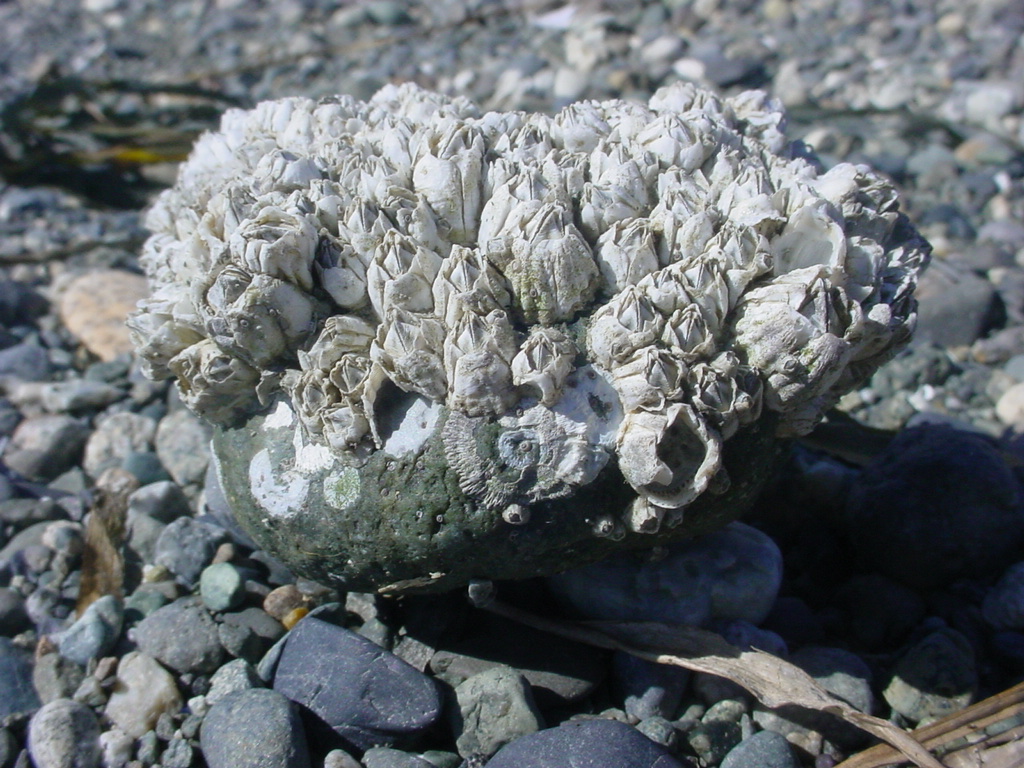
This group is clustered on a cobble at Ala Spit. Photo by
Dave
Cowles, September 2005
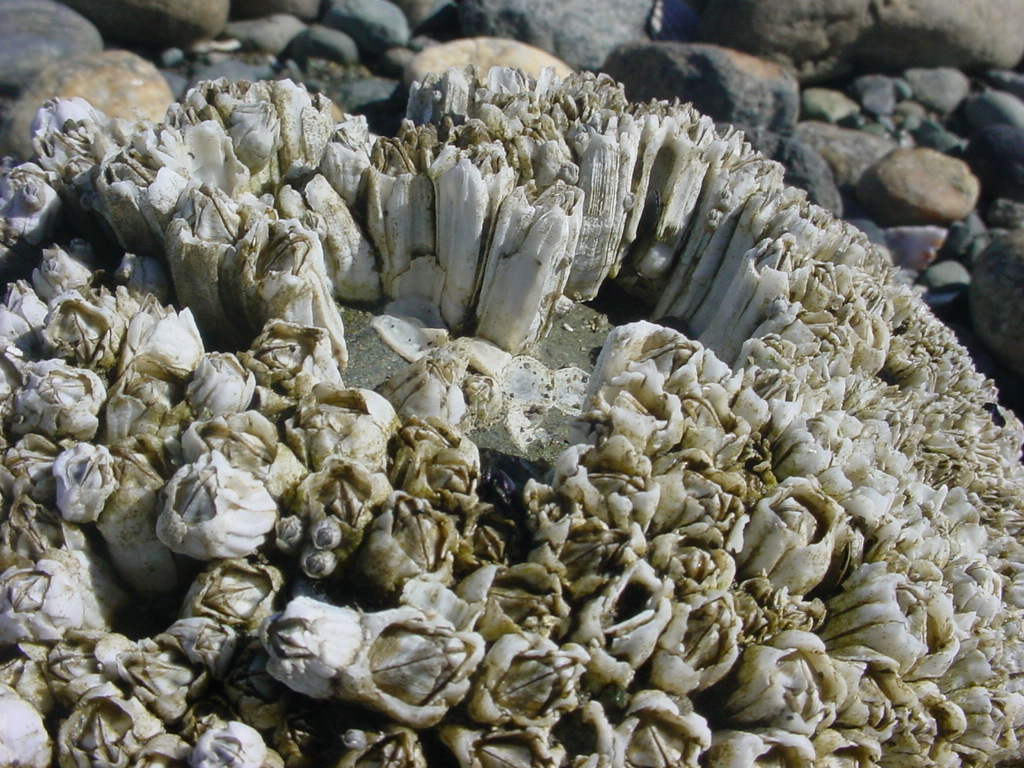
When individuals become too crowded, as on this rock, they grow in
a tall, thin columnar formation. Photo by Dave Cowles,
September
2005
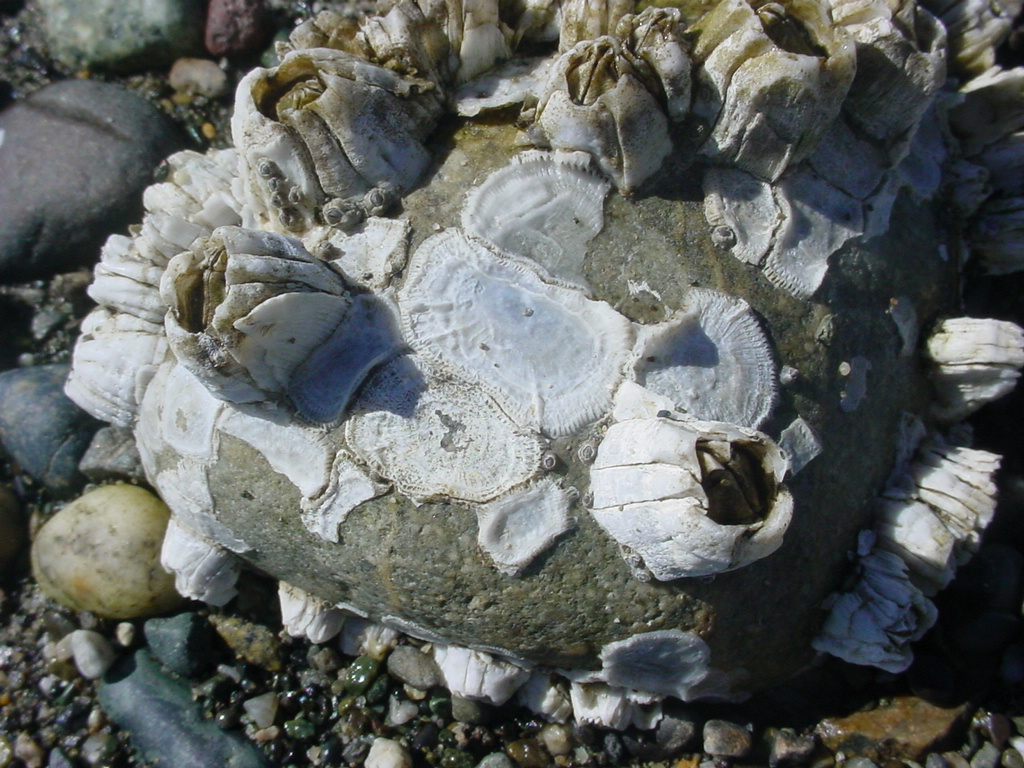
When individuals are dislodged from the rock they leave a
well-developed
calcified scar behind. Note also that the scar has a series
of centripetal
ridges especially around the margin. These two features, plus the lack
of a prominent beak on the tergum
and the dark patch caused by the thin spot on the scutum, are useful in
distinguishing B.
glandula
from Semibalanus
cariosus, another species common in the Pacific
Northwest intertidal.
Photo by Dave Cowles, September 2005
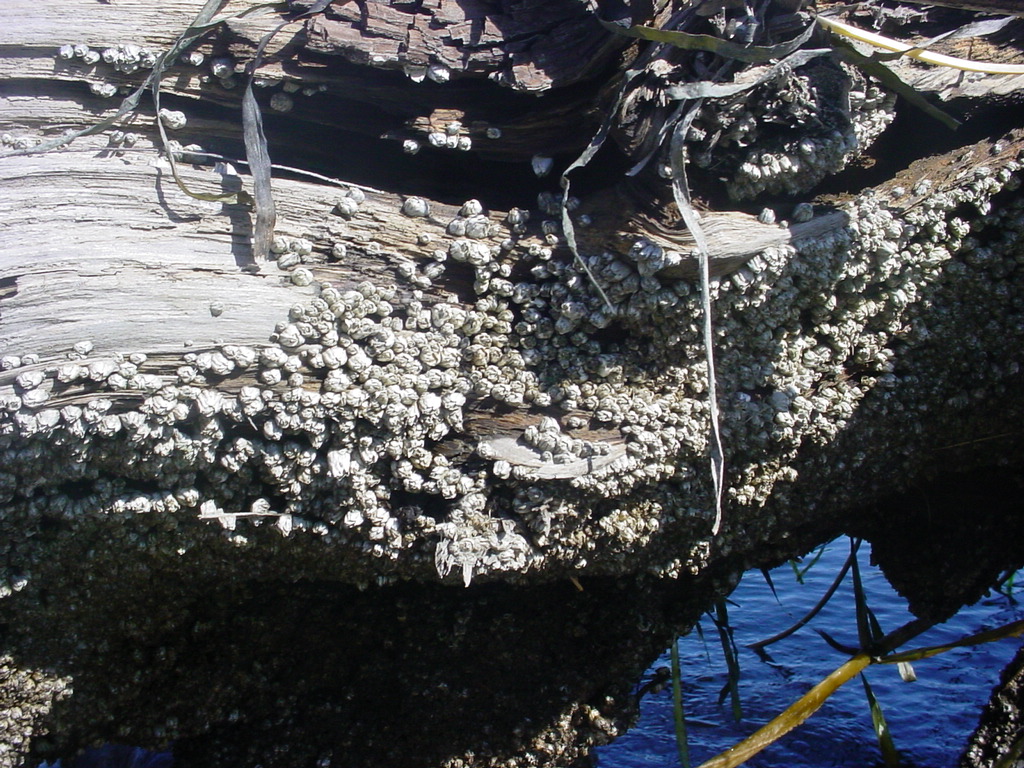
Unlike Chthamalus dalli, Balanus glandula
frequently
grow on other substrates such as the wood of this stump.
Photo by
Dave Cowles, September 2005.
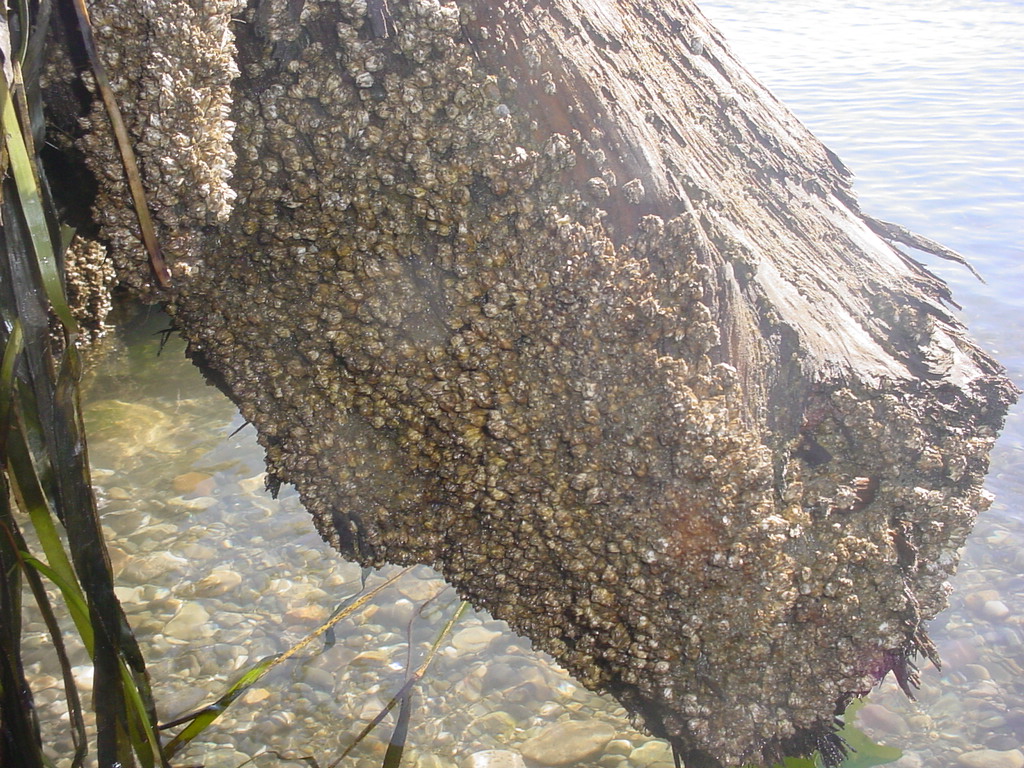
Balanus glandula is usually white or
gray-white, but these individuals
growing on a stump are mostly brownish, probably due to overgrowth by
diatoms
or other algae.
Authors and Editors of Page:
Dave Cowles (2005): Created original page